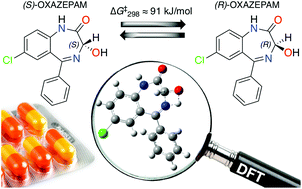Racemization of oxazepam and chiral 1,4-benzodiazepines. DFT study of the reaction mechanism in aqueous solution†
Abstract
The tranquilizer and hypnotic drug oxazepam undergoes the racemization process in aqueous medium, which is relevant for its pharmacological profile. The experimental barrier value (ΔG‡298 ≈ 91 kJ mol−1) was determined earlier, but the exact mechanism of enantiomerization is not known. Four different mechanisms have been proposed in the literature: C3–H/H exchange reaction, keto–enol tautomerization, solvolytic identity reaction, and ring-chain tautomerization. However, none of the reported reactions has been confirmed as the main pathway for racemization. In this work, all these mechanisms were subjected to comprehensive analysis performed by high-level quantum-chemical models. Two density functionals (B3LYP and M062X) were employed for geometry optimization of all stationary points at the corresponding potential surfaces, and the double-hybrid model (B2PLYP) was used for improved energy calculations. Out of all the tested mechanisms, only the ring-chain tautomerism fits the two experimental targets: the measured energy barrier and the pH-rate profile of racemization. The latter reveals that no acid/base catalysis is required for racemization to occur. The ring-chain tautomerism is initiated by intramolecular proton transfer from the C3-hydroxyl group to the imine nitrogen, which triggers the benzodiazepine ring opening and the formation of the achiral aldehyde intermediate. The latter undergoes ring closure which results in the inverted configuration at the C3-chiral atom of oxazepam. Our computational results suggest that the same mechanism is operative in the fast racemization of different 1,4-benzodiazepines, which posses the hydroxyl group at the stereogenic C3-centre (e.g. lorazepam or temazepam). In other benzodiazepine members (e.g. cinazepam or camazepam) the keto–enol tautomerization and/or the C3–H/H exchange mechanism may become relevant for their much slower racemization. This computational study is not only revealing in terms of mechanistic details, but also has predictive power for optical stability estimates in the family of benzodiazepines and similar heterocycles.

- This article is part of the themed collection: Mechanistic, computational & physical organic chemistry in OBC


 Please wait while we load your content...
Please wait while we load your content...